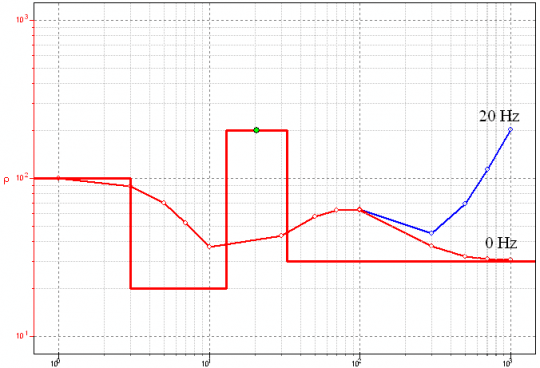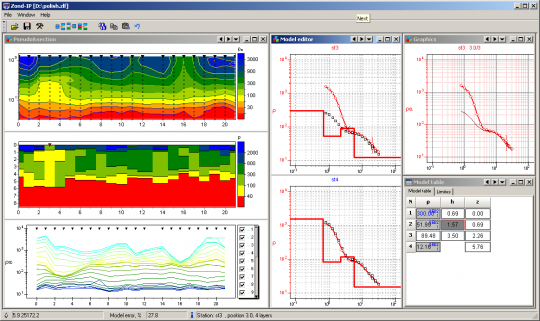ZondHED1D
ZondHED1D program is designed for one-dimensional data interpretation of AC vertical electric sounding (frequency mode).
A method of the vertical electrosounding (VES) is one of the oldest methods of electric prospecting. The first applications of method were in 20th years of XX century. Comparative simplicity and evidence of VES resulted in its wide distribution and development in the whole world. Nowadays vertical electric sounding remains one of the most applied electromagnetic methods. Other modern technologies are developed on the basis of VES – for example, electrical tomography, based on the same principles that for «classic» electric soundings.
Though the resistivity method is based on the direct current theory, technologically it is more convenient to use AC frequency mode. Between two grounded electrodes there is always some potential difference which is caused firstly by self polarization. To remove SP component use an AC mode and narrow-band filtration.
For working with ungrounded lines or at high level of industrial noise it is good solution to use higher frequencies. It more faster and increase reliability of received results.
The main problem in AC mode using is influence of an electromagnetic induction. The high frequency, spacing or conductivity give high induction influence. ZondHED1D taking account the frequency at forfard problem calculations. The layers properties for every layer – thickness and Cole-Cole parameters. Amplitude (it is used more often) and phase of response can be used both as observed data.
Comfortable interface and wide possibilities of data presentation allow to solve given geological problem with maximum effectiveness. While developing software special attention was payed to comfort and simplicity of its use, variety of visualization features and account of a priori data.
Depending on the interpreter’s choice, software gives different variants of data interpretation algorithms. Comfortable control system allows to choose from the great number of equivalents results that will appear to be the best in geophysical and geological point of view. Conception of multi-station interpretation is basis of the ZondHED1D software. Consequently, profile line data is considered as a reflection of geological section. It’s mean that multi-station data of profile line is whole, and not set of separated curves. Special windowed algorithms developed for interpretation of profile line data are provided in the software with every curve segment P-effect’s reduction. But most software features can be used also during work with the separated points of AC-VES.
Conception of multi-station interpretation is basis of the ZondHED1D software. Consequently, profile line data is considered as a reflection of geological section. It’s mean that multi-station data of profile line is whole, and not set of separated curves. Special windowed algorithms developed for interpretation of profile line data are provided in the software with every curve segment P-effect’s reduction. But most software features can be used also during work with the separated points of AC-VES. You can use areal XY survey with arbitrary lines orientation in multi-line mode.
ZondHED1d allows to work with any type of the electrode array or their combinations. Program supports both the traditional arrays (Schlumberger, Wenner or Dipole-dipole axial) and the most exotic, with an arbitrary orientation of electrodes and mixed systems, with taking account of frequency. Electrodes (source and measuring) can be located on one line or in arbitrary configuration on the plane. Data can be imported into the program in the formats of the most popular programs such as Ipi2win, IX1D.
As the basic task of the program is inversion of geoelectric section parameters – few variants of inverse problem are realized in ZondHED1D, basic of them are: smoothed inversion – to get smooth, and focusing – to get the piece-smooth distributing of geoelectric parameters vs depth. Because of equivalence of inverse geophysical problems, quality of the obtained results strongly depends on the amount of used a priori data. In ZondHED1D there is possibility of weight setting (Error gates) for measurements, fixing and limiting of different layers parameters, using of a priori model as reference in inversion. If the values of some section parameters are known exactly (a priori or on interpretation results), their fixing is possible before the beginning of automatic interpretation. The fixed parameters do not change during the process of inversion. Fixing of parameters is the method for hard regularization of inversion process. The robust schemas of noise estimation are realized in the program.
Version 27 / 8 / 2017 | Software: download

